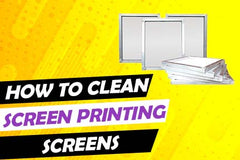If you are new to screen printing you may want to consider starting your business with screen print plastisol heat transfers. They can be one of the fastest ways to build a t-shirt business without spending a lot of money on new equipment. In this post we are going to tell you what a screen print transfer is, how to make them, and how to use them in your business. So let’s get started.
What is a Plastisol Heat Transfer?
A plastisol heat transfer is a screen print that is created on a piece of transfer paper. Then using a heat press the image is transferred to the garment. It is an actual plastisol print on the shirt.
Why You Should Use Plastisol Heat Transfers?
There are businesses that create heat transfers for themselves, and there are businesses that purchase the prints from 3rd party companies. We’ll discuss both.
Businesses That Create Their Own Heat Transfers
One of the major benefits of creating a heat transfer is that you don’t have to place the design on a shirt until you are ready. If you know that you are going to be selling a specific design at an event and you're not taking your entire screen printing setup with you then you can use heat press transfers to place the image on when you are ready. This eliminates waste. You will refrain from printing a lot of shirts that you potentially don’t need. You’ll save money by printing them on the transfer paper, rather than the shirts. When you are ready to make more shirts then you have the transfers ready to go and all you have to do is heat press the design onto the shirt. It takes about 3 minutes.
Another reason this is great is because you may have a very large order, but you are waiting on the shirts to come in. You can print the designs ahead of time and have them ready to go when the shirts come in. Then when the shirts come in your business can create the shirts and your screen printing press will be available for other jobs at the same time.
A business could also print the plastisol heat transfers and sell them to other t-shirt businesses. This is a way you can bring in some additional income and keep your machines working. There are a lot of reasons a business would want to print these transfers. Ultimately it is a business strategy that a business can use in their day to day operations.
Businesses Just Starting Out
When you are first starting to sell t-shirts you may not have the funds to pay for all of the equipment involved in screen printing. You still want your own designs on the shirts, but you don’t want to pay exorbitant prices to create your t-shirts. This is where the plastisol transfers come into play. The transfers can be ordered from 3rd party companies that specialize in creating plastisol heat transfers. You can create your own designs, then upload them to the company's website. Then they will print the designs and ship them to you. You can use a heat press and apply the transfers. Then sell the shirts and keep the profits.
The strategy here is to focus on your designs without focusing on the printing equipment and processes. The cost to get started is considerably less. You only need a heat press as your main piece of shop equipment. You can purchase a cheap heat press to get started, but you should really try to purchase a quality press. We’ve created a buying guide for heat presses to help you choose the right equipment.
How Are Plastisol Heat Transfers Created?
A screen printer sets up their work space as usual. They prepare the screen and the press as they normally would. Printing plastisol transfers works best with a conveyor dryer. The reason is that a special paper is used to create the transfers. This paper is called a transfer paper. It is designed to allow the release of the image onto the shirt. The paper needs to be very dry. The transfers don’t work very well with moisture even though most papers have some level of moisture in them. The paper must not have moisture in it. So before the paper is used you need to ensure that it is dry. You do this by running the paper through the conveyor dryer. When the paper comes out it will be crisp and moisture free. Then the paper is placed on the printer and printed as normal. Once the print is complete the print needs to be covered in a special screen print transfer powder. It can get quite messy. Once the image is covered in the powder you want to remove the excess powder. Shake the paper to remove the excess. Give the paper a flick to remove the excess. You want as much of the excess removed as possible because any excess powder can transfer onto the shirt when it is being heat pressed. (Excess powder left on a heat transfer can transfer onto the garment when it is pressed. Once you have removed the excess powder you simply run the transfer through the dryer again.
Warning. Do not use a flash dryer when creating heat transfers. The heat comes out uneven in a flash dryer and may not cure the ink on the paper.
Once the transfer comes out of the conveyor dryer it is able to be used. You can heat press the shirt with the new transfer. Once you have finished pressing the shirt the transfer must be peeled off. There are two types of heat transfer paper: hot peel and cold peel. The difference between the two types of paper comes in when you peel the paper off of the shirt. If it’s hot peel then you peel the paper off when it's hot. If it's cold peel then you peel it off when it's cold. So peel it off at the appropriate time and voila. You have a shirt that looks like it has gone through a normal screen printing process, but it hasn’t.
The Final Word On Screen Press Heat Transfers
Plastisol transfers are a great way to create screen printed t-shirts. They look exactly like a regular screen printed shirt. The prints come out looking great and they have the same stretch and feel as a regular screen print shirt. The concept is great for people just starting out in the business or those that have their businesses already up and running. Whatever you choose to do you will find plenty of tutorials and resources online to help you create incredible heat press transfers.




Leave a comment